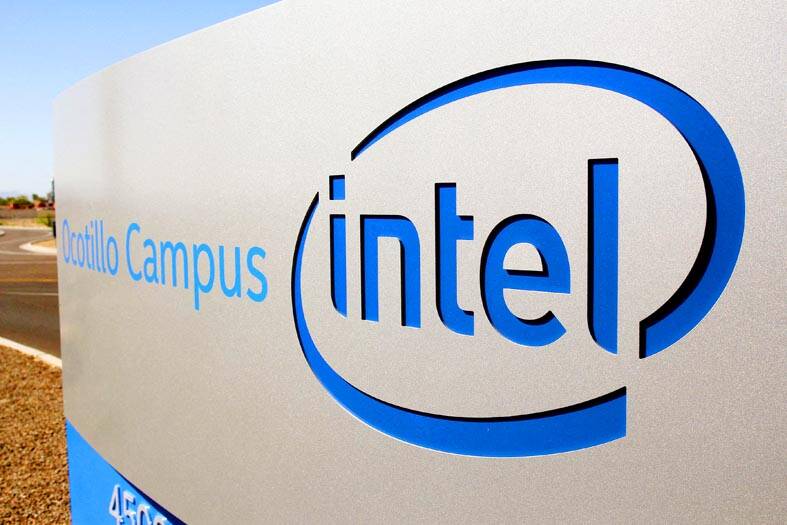The US is to award Intel Corp US$8.5 billion in grants and as much as US$11 billion in loans to help fund an expansion of its semiconductor fabs, the US Department of Commerce announced yesterday, marking the largest award from a program designed to reinvigorate the nation’s chip industry.
The package would support more than US$100 billion in US investments from Intel, including efforts to produce cutting-edge semiconductors at large-scale plants in Arizona and Ohio, the department said.
The money would also help pay for equipment research and development, and advanced packaging projects at smaller facilities in Oregon and New Mexico.

Photo: Reuters
In addition, Intel has indicated that it plans to tap investment tax credits from the US Department of the Treasury that could cover as much as 25 percent of capital expenditures, the commerce department said.
The subsidies come from the 2022 CHIPS and Science Act, which set aside US$39 billion in grants — plus loans and guarantees worth US$75 billion — to convince chip companies to build factories on US soil.
For Intel, the facilities are part of an ambitious turnaround bid under CEO Pat Gelsinger. The effort has included building up a foundry business — an operation that makes chips for other companies — and Intel recently secured Microsoft Corp as a high-profile customer.
Gelsinger has also been trying to restore Intel’s technological capabilities. The company had in the past few years fallen behind Asian rivals Taiwan Semiconductor Manufacturing Co (台積電) and Samsung Electronics Co in that area. The latter two are also stepping up US expansion plans and are expected to receive their own CHIPS Act awards in the coming weeks.
Intel is the first company to land a preliminary CHIPS Act funding deal for advanced chipmaking facilities. Earlier awards went to companies producing older-generation semiconductors.
Gelsinger said that it has been economically uncompetitive to build plants in the US compared with East Asia.
These awards help redress that imbalance, he said.
The money is to be disbursed after a due diligence stage, and it is to come in tranches tied to production goals and other benchmarks set by the commerce department, with officials expecting money to start flowing in at the end of this year.
Intel’s award would be the “single-biggest announcement of a grant to any CHIPS recipient,” US Secretary of Commerce Gina Raimondo told reporters ahead of the news.
The projects would create more than 30,000 construction and manufacturing jobs across four states, she said, adding that US$50 million of Intel’s award would specifically go into workforce development.
The timeline for those jobs would vary from facility to facility, she said, adding that Intel’s construction plans remain in line with its initial projections.
The first of several Arizona facilities would be operational by the end of this year, and the chipmaker expects the construction in Ohio to finish in late 2026, she said.
The funding announced yesterday is focused solely on commercial production.
However, Intel is also expected to receive about US$3.5 billion in funding for manufacturing of military and intelligence chips. That grant has thrown a wrench into broader CHIPS Act negotiations over the past few weeks, because the Pentagon pulled out from a plan to foot more than two-thirds of the bill.

CHIP RACE: Three years of overbroad export controls drove foreign competitors to pursue their own AI chips, and ‘cost US taxpayers billions of dollars,’ Nvidia said China has figured out the US strategy for allowing it to buy Nvidia Corp’s H200s and is rejecting the artificial intelligence (AI) chip in favor of domestically developed semiconductors, White House AI adviser David Sacks said, citing news reports. US President Donald Trump on Monday said that he would allow shipments of Nvidia’s H200 chips to China, part of an administration effort backed by Sacks to challenge Chinese tech champions such as Huawei Technologies Co (華為) by bringing US competition to their home market. On Friday, Sacks signaled that he was uncertain about whether that approach would work. “They’re rejecting our chips,” Sacks

It is challenging to build infrastructure in much of Europe. Constrained budgets and polarized politics tend to undermine long-term projects, forcing officials to react to emergencies rather than plan for the future. Not in Austria. Today, the country is to officially open its Koralmbahn tunnel, the 5.9 billion euro (US$6.9 billion) centerpiece of a groundbreaking new railway that will eventually run from Poland’s Baltic coast to the Adriatic Sea, transforming travel within Austria and positioning the Alpine nation at the forefront of logistics in Europe. “It is Austria’s biggest socio-economic experiment in over a century,” said Eric Kirschner, an economist at Graz-based Joanneum

BUBBLE? Only a handful of companies are seeing rapid revenue growth and higher valuations, and it is not enough to call the AI trend a transformation, an analyst said Artificial intelligence (AI) is entering a more challenging phase next year as companies move beyond experimentation and begin demanding clear financial returns from a technology that has delivered big gains to only a small group of early adopters, PricewaterhouseCoopers (PwC) Taiwan said yesterday. Most organizations have been able to justify AI investments through cost recovery or modest efficiency gains, but few have achieved meaningful revenue growth or long-term competitive advantage, the consultancy said in its 2026 AI Business Predictions report. This growing performance gap is forcing executives to reconsider how AI is deployed across their organizations, it said. “Many companies

Taiwan’s long-term economic competitiveness will hinge not only on national champions like Taiwan Semiconductor Manufacturing Co. (TSMC, 台積電) but also on the widespread adoption of artificial intelligence (AI) and other emerging technologies, a US-based scholar has said. At a lecture in Taipei on Tuesday, Jeffrey Ding, assistant professor of political science at the George Washington University and author of "Technology and the Rise of Great Powers," argued that historical experience shows that general-purpose technologies (GPTs) — such as electricity, computers and now AI — shape long-term economic advantages through their diffusion across the broader economy. "What really matters is not who pioneers